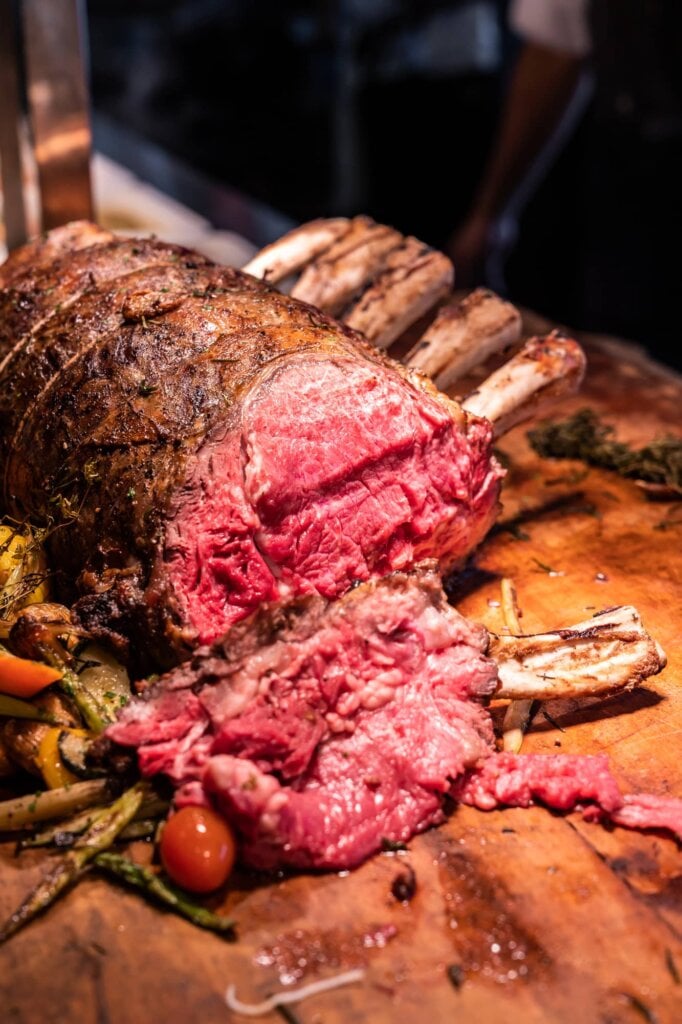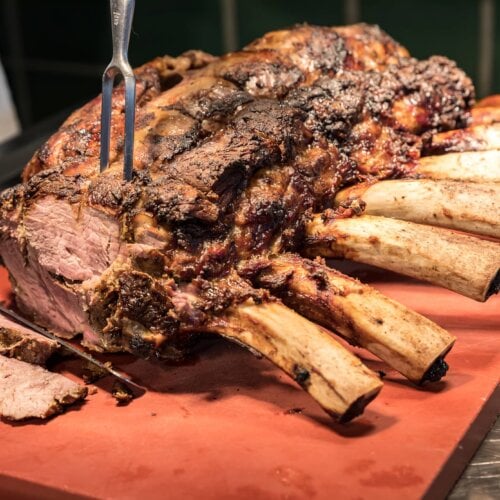
Carving a beautiful pink and juicy Prime Rib is a holiday tradition for many families. It’s also a show-stopping entree for a special celebration dinner like a birthday or anniversary. Whatever your reason for considering Prime Rib or a Standing Rib Roast rather than a Filet Mignon, you’ll want a forgiving cooking method. This is one of the most expensive cuts of beef, especially if you seek out a higher USDA grade cut of meat. Make sure you’re getting the tender and evenly cooked results you want by using a slow and low roasting method that requires only your home oven and a few pieces of kitchen equipment.
What Exactly is Slow Roasting?
Roasting often involves a medium to high heat level to help foods cook quickly and develop a lot of browning. In contrast, slow roasting uses a low temperature and a longer cooking period. It’s not uncommon for some slow-roasting recipes to call for hours of continuous cooking. While you’ll need an afternoon to commit to roasting a Prime Rib this way so it’s ready in time for dinner, it’s worth the extra effort. You only need your home oven and a meat thermometer to use this method of cooking. There are a number of benefits to slow roasting a large cut of meat like this one over a more rapid cooking method.
The Benefits of Slow Roasting
First, slow roasting produces a Prime Rib that is tender, juicy, and has evenly cooked meat. It’s hard to avoid uneven cooking with higher heat levels due to the size and density of this cut of beef. If you’ve ever cut your roast into slices and noticed a gray ring of meat around the edges, this is due to uneven cooking. For pink meat all the way to the edge, you’ll want to keep your oven temperature under 300 degrees F. Slow roast Prime Rib also tends to offer a better depth of flavor because the fat melts and infuses into the rest of the meat. You always have a chance at the end of the cooking process to reverse sear the surface and add all the texture you want without overcooking the center.
Tips and Tricks to Slow Roast Prime Rib
Slow roasting doesn’t require as much expertise as smoking or grilling an entire Prime Rib, making it a good choice for beginners. It’s easy to return the Prime Rib to the oven for extra cooking time if it’s not done when you check it, allowing you to be sure of your work. Use these tips to get the best results from your Prime Rib roasting efforts from your very first attempt.
Which Pan is Best for Slow Roasting?
The one piece of equipment you’ll need for this method that you might not have is a heavy-duty roasting pan. A cast iron Dutch oven can work, but it needs to be large and might be a little too heavy to lift in and out of the oven with the Prime Rib in it. Thinner steel and aluminum roasting pans covered in enamel are a popular choice for slow roasting. Avoid disposable roasting pans unless it’s your only option. Your roasting pan needs a tight-fitting lid, or you can use aluminum foil to create one in a pinch. Finally, you’ll also need a rack that fits into the roasting pan so the Prime Rib doesn’t sit on the bottom. This allows you to collect drippings for making gravy or au jus as well as providing space for adding liquid like beef broth to moisten the roast as it cooks.
Reverse Searing
Slow roast Prime Rib stays pink and juicy, especially on the inside. If you want a little more browning and a firmer texture on the exterior, it’s best accomplished with a reverse sear. Standard searing involves browning the meat in a pan on all sides before the rest of the cooking begins. While it’s still a common method used for steaks like the Porterhouse, it’s now being replaced by the reverse searing process. When cooking Prime Rib, you’ll get the best results from completing the slow roast first and coming within 5 to 10 degrees of your desired internal temperature. Then you’ll use a hot cast iron pan or a higher heat setting on the oven to quickly sear the exterior at the very end.
Resting the Roast
After cooking and searing, the Prime Rib will need a rest to help the juices redistribute between the muscle groups. Rest the slow roast Prime Rib for 20 to 30 minutes at least before slicing.
Bringing Prime Rib to Room Temperature
Before you begin roasting the Prime Rib, it’s best to bring it to near room temperature. This allows the entire piece of meat to start cooking at the same time. Without around 45 minutes to 1 hour to come to room temperature first, the meat is likely to remain at a lower temperature in the center while cooking quickly on the outside.
Preparing the Prime Rib
Aside from letting the meat come to room temperature, there are a few steps in preparing the Prime Rib that really maximize the flavor. Get the most out of your next roast by choosing the right seasonings and considering a butter rub.
Best Sauces and Seasonings
It’s perfectly fine to season a Prime Rib with nothing but Kosher salt and cracked black pepper, especially when using the slow roasting method. Other fun seasoning combinations include:
- Thyme, oregano, black pepper, and rosemary
- Smoked paprika, brown sugar, cayenne pepper, and cumin
- Garlic powder, onion powder, and mixed Italian herb rub
- Dry mustard, celery seeds, crushed red pepper, and oregano.
Aside from seasoning the meat before you slow roast it, you can also pair a number of different sauces with the sliced Prime Rib. Creamy horseradish sauce or peppercorn sauce are two classic options for spicy flavor lovers, while au jus or brown gravy is more mellow and appeals to diners of all ages.
Seasoning Overnight
One option to increase the effectiveness of any seasoning or rub you choose is to apply the dry spices the night before, then wrap the meat tightly with plastic wrap. This traps the rub against the surface and helps the meat’s natural juices absorb the flavors into it.
Butter Rubs for Prime Rib
Increase the tenderness even further by rubbing your Prime Rib with butter before applying any seasonings or spices. Unsalted butter softened to room temperature works best without adding too much salt to your rub or seasoning.
Slow Roasted Prime Rib Recipe

Use your home oven to turn out a beautiful Prime Rib with this easy recipe.
Ingredients
- 1 whole bone-in Prime Rib, fat cap trimmed so it’s no thicker than 1 inch
- 2 tablespoons of Kosher salt
- 1 tablespoon of cracked black pepper
- 2 tablespoons of canola oil or 4 tablespoons of softened butter
Instructions
1. Take the Prime Rib out of the refrigerator and let it warm up for 45 minutes to 1 hour. Apply the oil or butter and rub the seasonings on the surface.
2. Preheat the oven to 225 degrees F for a standard model and 200 degrees F for a convection oven. Set your rack in the bottom of your roasting pan. Place the Prime Rib on the rack, then add about 1 inch of beef broth or water to the roasting pan.
3. Put the lid on the roasting pan and put it in the oven. Let the meat roast for approximately 3 to 4 hours. Check it around the 3 hours mark, using an instant-read probe thermometer. Aim for 110 degrees for rare, 120 degrees for medium rare, 125 degrees for medium, and no more than 130 degrees.
4. Take the roasting pan out of the oven. Turn the oven up to 500 degrees F and let it reach that temperature, or heat 2 tablespoons of high-heat oil in a large cast iron pan. Sear the roast by placing it uncovered in the hot oven for around 10 minutes or by searing each side of the roast in the pan for 2 to 3 minutes per side.
5. Let stand for at least 20 to 30 minutes under an aluminum foil tent to rest, then slice and serve.
Slow Roasted Prime Rib – Nutritional Facts
Per Serving (based on 8 servings, based on a 2,000-calorie daily diet)
| Nutrient | Amount (% Daily Value (DV)) |
|---|---|
| Calories | 560 (28%) |
| Total Fat | 42g (54%) |
| Saturated Fat | 17g (85%) |
| Trans Fat | 1.5g |
| Cholesterol | 135mg (45%) |
| Sodium | 850mg (37%) |
| Total Carbohydrate | 0g (0%) |
| Dietary Fiber | 0g (0%) |
| Total Sugars | 0g |
| Added Sugars | 0g (0%) |
| Protein | 42g (84%) |
| Vitamin D | 0.3mcg (2%) |
| Calcium | 24mg (2%) |
| Iron | 4.0mg (22%) |
| Potassium | 640mg (14%) |
Conclusion
Transform a large cut of beef into a luscious and perfectly cooked Prime Rib dinner with our help. You’ll find only the best steaks and other beef options here at Chicago Steak Company.

Slow Roasted Prime Rib
Ingredients
- 1 whole bone in prime rib, fat cap trimmed so it's no thicker than 1 inch
- 2 tbsp kosher salt
- 1 tbsp cracked black pepper
- 2 tbsp canola oil or 4 tbsp softened butter
Instructions
- Take the Prime Rib out of the refrigerator and let it warm up for 45 minutes to 1 hour. Apply the oil or butter and rub the seasonings on the surface
- Preheat the oven to 225 degrees F for a standard model and 200 degrees F for a convection oven. Set your rack in the bottom of your roasting pan. Place the Prime Rib on the rack, then add about 1 inch of beef broth or water to the roasting pan
- Put the lid on the roasting pan and put it in the oven. Let the meat roast for approximately 3 to 4 hours. Check it around the 3 hours mark, using an instant-read probe thermometer. Aim for 110 degrees for rare, 120 degrees for medium rare, 125 degrees for medium, and no more than 130 degrees
- Take the roasting pan out of the oven. Turn the oven up to 500 degrees F and let it reach that temperature, or heat 2 tablespoons of high-heat oil in a large cast iron pan. Sear the roast by placing it uncovered in the hot oven for around 10 minutes or by searing each side of the roast in the pan for 2 to 3 minutes per side
- Let stand for at least 20 to 30 minutes under an aluminum foil tent to rest, then slice and serve

